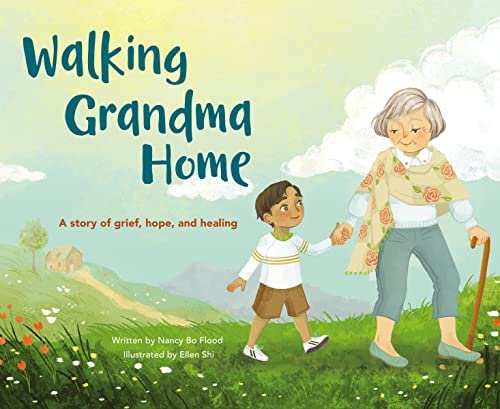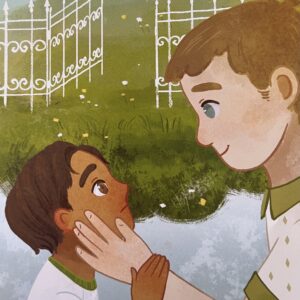
Zonderkidz | 978-0310771241
In the tender story, WALKING GRANDMA HOME by Nancy Bo Flood, a young boy named Lee learns that his elderly grandmother is dying. “Little Lee,” she says, “I’m going away soon, going home.” Lee wonders – Isn’t Grandma already home? Just last summer at a family wedding, he had helped her “walk down the long aisle” as his cousin, Maria, “skipped and twirled” tossing rose petals. But since then, things have changed. Grandma has had a stroke and is not the same. Lee knows it’s serious. “Even lots of Band-Aids won’t help.”
As the time draws near, and the extended family gathers, Uncle Tony does not shy away from the truth: “Today, we are all here to say good-bye. Grandma is dying.” Lee is quiet and sad: “I don’t want to say that kind of good-bye.”
Flood’s sensitive text, warmly illustrated by Ellen Shi, provides a truly beautiful way for children to process emotions, talk through questions, and move through the grieving process alongside a caring adult, all while remembering and honoring the loved one’s life.
© illustration by Ellen Shi
I’m so glad Nancy agreed to answer a few questions about her process in writing this book and for sharing how her personal experiences with loss led her to write a book that is a gift to parents, caregivers, and counselors who are looking for a way to help a child process the myriad emotions that accompany grief in a healthy way.
Dianne: Most of the stories we write begin with a small seed of an idea. Walking Grandma Home is a book you’ve wanted to write for some time, the idea rooted in your personal experiences with grief, both as a child, and as an adult. Finding the right way to tell such a story – and from the perspective of a young child – is not easy. Can you share briefly the decisions you made as you began to explore the story you wanted to tell?
Nancy: After several attempts to figure out how to begin, I realized that this story needed to begin with family and begin with “normal” and celebration. A wedding is a time of family and celebration. It also reflects the sense of cycles of life. I also wanted to show how the child is part of each cycle (helping Grandma walk down the aisle, helping with her cane), to show not only the emotional connection but in specific ways, how is the child helpful? How can children show their love and concern? And then, what are the child’s questions and how does family help the journey of understanding what is happening (asking Uncle Tony the questions many children want to ask but often are afraid to ask). Throughout the story, the child in different ways and with different family members, continues to be part of the journey, especially giving grandma her shawl (in case she is a little bit scared). Often a child wants to give the person who is ill, a favorite stuffed animal, book, or toy – a Lego figure he made, a card he decorated. Being allowed to show love and caring is an important way children can feel included and also can express feelings which reinforces a sense of connection.
I chose first person because I felt that this was every child’s story – including grown-ups as they remember past losses. I hope this encourages the reader to feel like these are their questions and in this book it is okay to ask, to challenge, to wonder. Death is a mystery. No one has all the answers and we all have questions.
Dianne: The title WALKING GRANDMA HOME is powerful. Both in the imagery and the comfort it offers as a way to think of death as a walk home. Was that a phrase in your head right from the beginning, or did it come later, as you worked on telling the story?
Nancy: “Walking Grandma Home” was the first phrase the echoed in my head when I began writing this book. As my mother was dying, it was her phrase – almost. Her last year of life she often said to me, “My work is done. My bags are packed. I’m waiting for the bus.” During her last week of life with all her children present, she repeatedly said, with such a positive sense of ready: “I’m going home, I’m going home.” Since then, I was told by several Hospice volunteers that they often hear this phrase. I was surprised to discover that those words are also spoken in other places, by people of other cultures.
Dianne: Writing for a young audience about a difficult topic is no easy task. And yet you have seamlessly woven a gentle and soothing story that opens space for conversations around grief and the loss of a loved one. At the end of the book, you provide some questions and activities that parents, caregivers, and counselors can use to approach the grieving process in child-appropriate ways.
For those readers who have not yet had a chance to pick up a copy of the book, can you offer a few tips to help parents who are currently navigating the waters of grief with their child or a young loved one (or who recognize they will be, at some time in the near future)?
Nancy: The unknown, the silence, is far more scary to a child than what is explained, what is the truth. If adults won’t talk about “something,” that “something” must be too awful to even name. Then a child imagines the worst.
Invite. Include. Don’t leave the child out. Don’t leave the child on the other side of the closed door, alone and wondering, hearing the whispering. Allow space for questions. Model with your own questions.
Be honest. Don’t pretend everything is okay. A child knows everything is not okay.
Be patient. Grieving comes with many different emotions – anger, fear, guilt, sadness, loneliness, and silence. Emotions are shown in many different ways – isolating oneself, striking out, misbehaving, being silly, denial, regression — do keep reasonable “boundaries of behavior.” Children also want to know that adults are still in charge, still holding their world together. Listen and reassure that time offers healing. Grieving is a journey that takes time. The sadness and pain gradually diminishes; the joy of remembering increases. Laughter shared is healing. Sharing memories and stories help us all, old and young.
Dianne: Thank you, Nancy, for writing a book that I know many will want to turn to if they have young ones in their lives who have experienced loss.
***
Additional Resources:
- An Activity and Rememberance Guide to accompany the book
- A short video with the author about Walking Grandma Home. (courtesy of Winding Oak)











